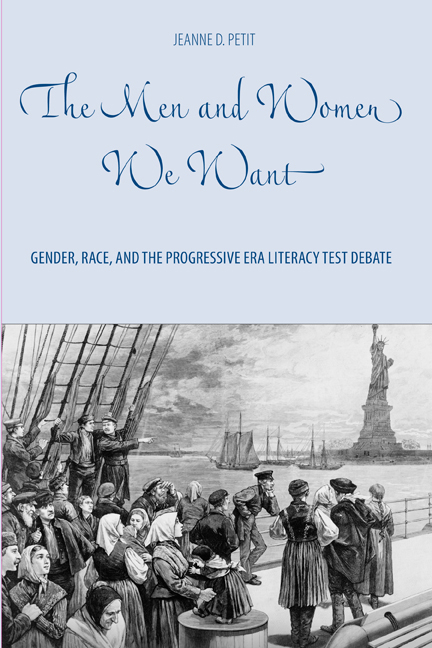Book contents
- Frontmatter
- Dedication
- Contents
- List of Illustrations
- Acknowledgments
- Introduction
- 1 Breeders, Workers, and Mothers: The Beginning of the Literacy Test Debate
- 2 Parents and Progeny: The Dillingham Commission Report
- 3 Muscle, Miscegenation, and Manhood: The Literacy Test at the Height of the Progressive Era
- 4 Practical Aid and Sympathetic Understanding: Grace Abbott's Alternative to the Literacy Test
- 5 World War I and the Literacy Test
- 6 The Legacy of the Progressive Era Literacy Test Debate
- Notes
- Bibliography
- Index
2 - Parents and Progeny: The Dillingham Commission Report
Published online by Cambridge University Press: 14 March 2018
- Frontmatter
- Dedication
- Contents
- List of Illustrations
- Acknowledgments
- Introduction
- 1 Breeders, Workers, and Mothers: The Beginning of the Literacy Test Debate
- 2 Parents and Progeny: The Dillingham Commission Report
- 3 Muscle, Miscegenation, and Manhood: The Literacy Test at the Height of the Progressive Era
- 4 Practical Aid and Sympathetic Understanding: Grace Abbott's Alternative to the Literacy Test
- 5 World War I and the Literacy Test
- 6 The Legacy of the Progressive Era Literacy Test Debate
- Notes
- Bibliography
- Index
Summary
In the first decade of the twentieth century, the parameters of the literacy test debate were transformed. The economic growth of the early twentieth century led to a huge demand for labor and, consequently, a spike in immigration. Over ten million immigrants arrived in that decade, the vast majority from southern and eastern Europe. Overall wages increased and unemployment remained low, which weakened the restrictionists’ case that immigration hurt working men. At the same time, the growth of the progressive movement had called into question much of the laissez-faire policies of the past, including policies about immigration. The presidency of Theodore Roosevelt shook up the established political order and Roosevelt justified the use of government power to curb the excesses of industrialization. More and more native-born Americans began to perceive the rising numbers of immigrants as perpetuating the social problems of the industrial economy, and the Immigration Restriction League (IRL), when it reemerged, continued to push the idea that a literacy test designed to rein in immigration was a logical solution. President Roosevelt spoke out publicly for the need for government action to solve what had become known as the immigrant problem, and in 1907 he called for a mammoth congressional study of immigration to the United States. The President charged the Immigration Commission, also known as the Dillingham Commission, to study the impact of immigration on all levels of society and to decide whether a literacy test was the best legislative approach to the immigrant problem. During this same time, new participants were entering the literacy test debate, including a new organization that had formed out of Hull House in Chicago: the Immigrants’ Protective League (IPL).
When the leaders of the Immigration Restriction League and the Immigrants’ Protective League were asked to submit statements to the Dillingham Commission, they saw it as an opportunity to have their views of the nation validated by national legislation. In true progressive form, they bolstered their arguments about immigration legislation with statistics, case studies, and testimony from scientific and social scientific experts. Their approaches were alike in other ways as well.
- Type
- Chapter
- Information
- The Men and Women We WantGender, Race, and the Progressive Era Literacy Test Debate, pp. 31 - 58Publisher: Boydell & BrewerPrint publication year: 2010



